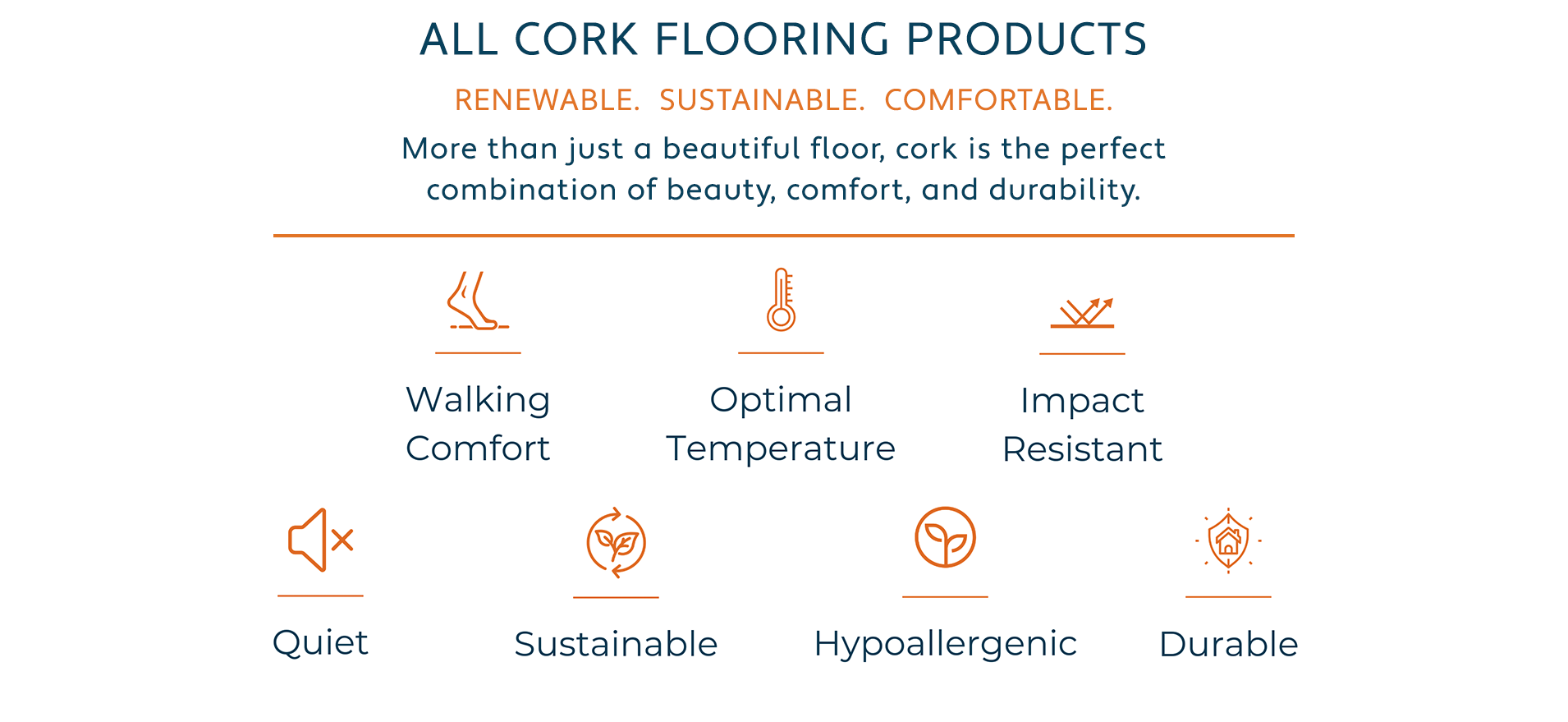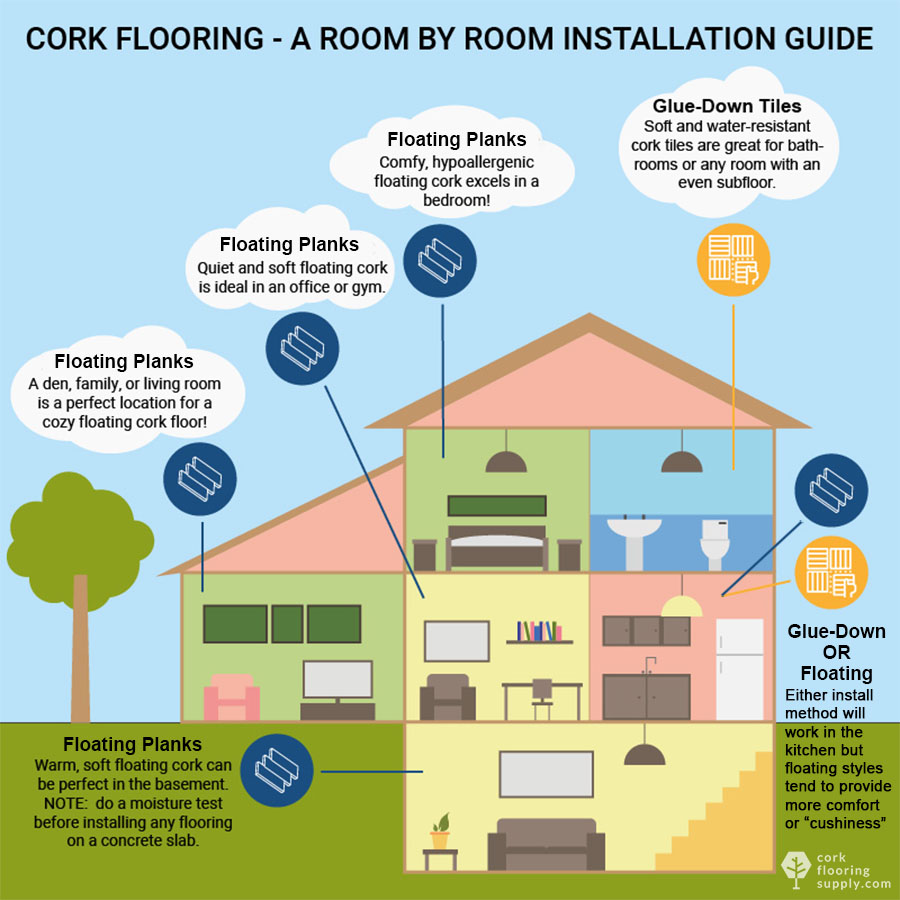Cork Flooring

Find your new favorite floor by browsing our complete selection of cork flooring below.
You'll find cork planks and cork tiles, in both glue-down and click-together (floating floor) installation applications.
Wicanders Cork Essence 7/16" Floating Cork Flooring - Fashionable Cement
Wicanders Cork Essence 7/16" Floating Cork Flooring - Identity Timide
Wicanders Cork Essence 7/16" Floating Cork Flooring - Novel Edge Natural
Wicanders Cork Essence 7/16" Floating Cork Flooring - Originals Accent
Wicanders Cork Essence 7/16" Floating Cork Flooring - Personality Chestnut

Best Installation Method for Each Room - Floating vs. Glue-Down
Cork's unique properties make it an ideal flooring choice for any room in your home. But there are a few factors that will determine which installation method is best for each room, including:
- location of the room in your home
- the amount of foot traffic in the room
- the amount of moisture or risk of water spillage in the room
FLOATING FLOORS
Floating cork flooring does not need to be nailed or glued to the subfloor. The floating installation method is used to install engineered cork planks and panels that simply lock or click together using a tongue-and-groove system. You may have heard floating floors referred to as "click" flooring for that very reason. Because they're easy to install, many homeowners choose to put it in themselves rather than hire a professional installer. The floating application sits right on top of virtually any smooth surface, which makes it ideal for do-it-yourself renovation projects.
The floating method of installation will work in many rooms in your home, with the exception of really wet locations (bathrooms, mudrooms, laundry rooms or possibly entry ways). We recommend floating cork as a healthy alternative to lower-end, toxic flooring materials such as luxury vinyl tiles (LVT), vinyl planks or laminate. Another way to think about where you would install a floating cork floor is to ask, "where would you put carpet?". Cork is very similar to wool carpet in that both are made from organic materials and are quiet, soft, warm and provide sound dampening. You wouldn't install carpeting in your bathroom, so it's best not to install a floating floor with an HDF core that could potentially sustain damage from too much contact with water, either.
Floating cork planks are recommended for:
- Bedrooms
- Offices
- Kitchens
- Living Rooms
- Dining Rooms
- Dens
- Basements
- Gyms, yoga or workout rooms
GLUE DOWN FLOORS
On the other hand, glue-down cork tiles are recommended for commercial and residential areas with higher traffic, potentially wetter areas like bathrooms with showers, kitchens, or laundry rooms. That's why you'll often see the glue-down cork tiles in the galleys of ships or high traffic commercial spaces such as bank lobbies, libraries and museums.There's a lot of misinformation out there about cork flooring and moisture. Some pros advise against installing cork in wetter areas. However, if installed correctly, glue-down cork tiles are ideal for such rooms. Though cork looks like it has a spongy consistency, cork does not absorb water like a sponge. Cork floats! It's considered impermeable yet breathable which is why it's water resistant and oh-so buoyant. Think buoys, fishing net floats, wine corks, etc. Also consider that cork is used in engine gaskets to hold back liquid and pressure.
Glue-down cork tiles are recommended for:
- Bathrooms with showers
- Laundry Rooms
- Kitchens
- Mudrooms / Entry Ways in wet climates
Cork Flooring in Kitchens
For the most part, glue-down cork floors can be installed in every room of your home. The decision is more about where floating floors can be installed. For instance, you probably noticed that we listed the kitchen as a room where both floating and glue-down cork can be installed. Even though kitchens are potentially wetter areas, we like floating cork in the kitchen because it often provides more cushioning than solid, glue-down cork. This is most likely due to the difference in thickness between the two products as well as the additional layers inherent in the construction of engineered flooring. Also, solid cork tiles aren't as thick as they once were. The original cork tiles in some of the older libraries and museums were 1/2" to 1" thick. Today's solid cork tiles are either 3/16" or 5/16" thick.
Cork Flooring in Basements (floors below ground level)
Special consideration should be made for basements, due to the possibility of below-grade (or below ground level) moisture. Before installing any floor covering in a basement, consider doing a moisture test, such as a calcium chloride or relative humidity test, on your concrete slab. If the concrete subfloor moisture content is considered acceptable for the cork flooring you want to install, including a floating cork floor, then go for it. If it's determined that the moisture level is too high, don't despair! You have options for healthy, efficient moisture mitigation products like vapor retarders, barriers, as well as non-toxic sealers and adhesives. Measuring and planning for potential moisture problems before installing any flooring can eliminate future flooring failure and ensure your new cork floor lasts a lifetime.
In general, it's a good idea to proceed with caution when installing any type of flooring in rooms prone to heavy moisture or water spillage. And always follow the manufacturer's instructions to ensure your warranty is not voided. We're happy to discuss cork installation, suggestions and tips for any room - just contact us!





 ,
Line Name
,
Line Name





























